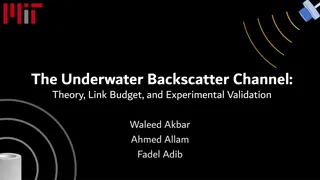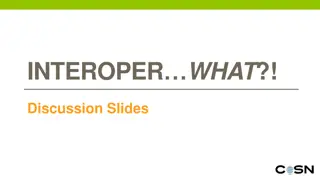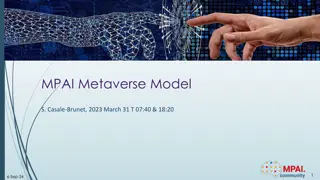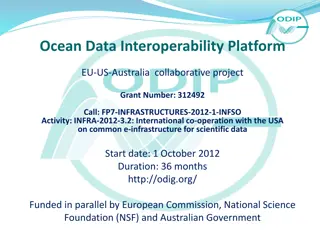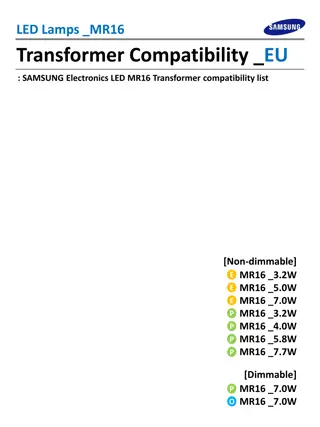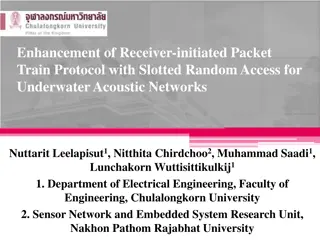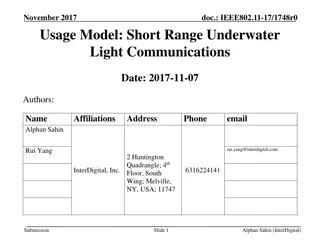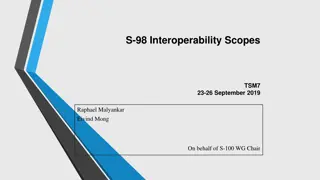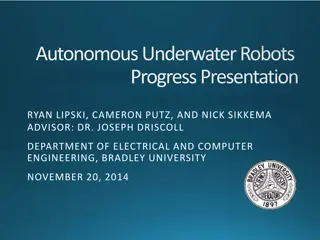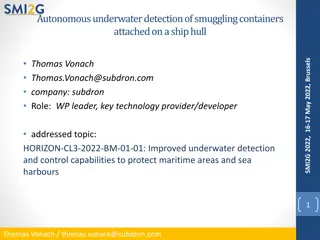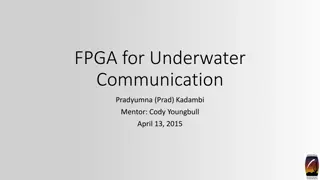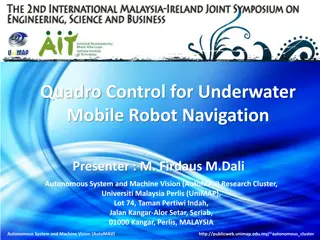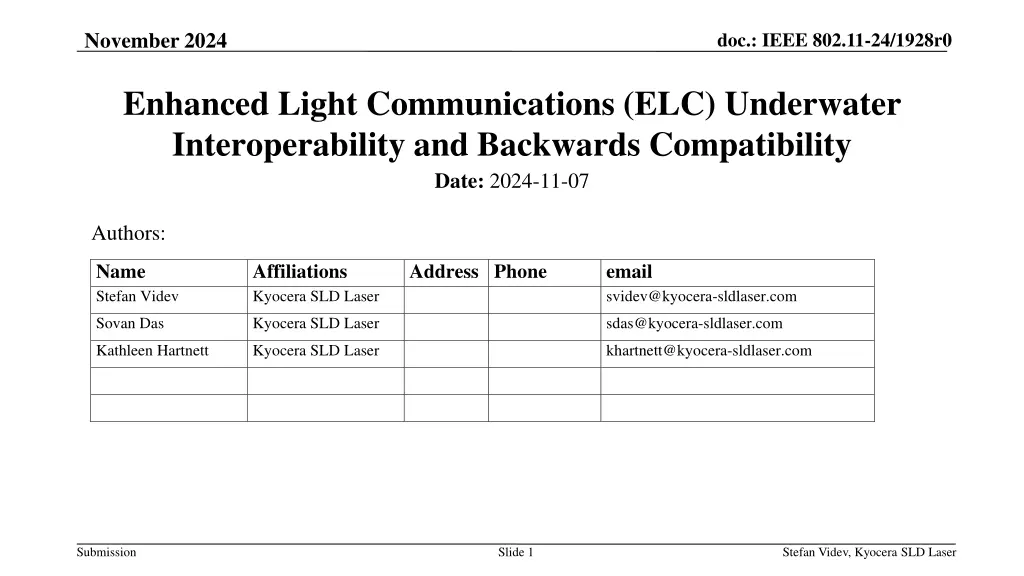
Enhanced Light Communications in Underwater Environments
Explore the potential of Enhanced Light Communications (ELC) for underwater interoperability and backwards compatibility in IEEE 802.11 standards. Learn about optimal wavelengths, LiFi operations, interoperability challenges, and the debate on backwards compatibility. Discover the implications for underwater communication technologies and future system designs.
Uploaded on | 2 Views
Download Presentation

Please find below an Image/Link to download the presentation.
The content on the website is provided AS IS for your information and personal use only. It may not be sold, licensed, or shared on other websites without obtaining consent from the author. If you encounter any issues during the download, it is possible that the publisher has removed the file from their server.
You are allowed to download the files provided on this website for personal or commercial use, subject to the condition that they are used lawfully. All files are the property of their respective owners.
The content on the website is provided AS IS for your information and personal use only. It may not be sold, licensed, or shared on other websites without obtaining consent from the author.
E N D
Presentation Transcript
November 2024 doc.: IEEE 802.11-24/1928r0 Enhanced Light Communications (ELC) Underwater Interoperability and Backwards Compatibility Date: 2024-11-07 Authors: Name Stefan Videv Affiliations Kyocera SLD Laser Address Phone email svidev@kyocera-sldlaser.com Sovan Das Kyocera SLD Laser sdas@kyocera-sldlaser.com Kathleen Hartnett Kyocera SLD Laser khartnett@kyocera-sldlaser.com Submission Slide 1 Stefan Videv, Kyocera SLD Laser
November 2024 doc.: IEEE 802.11-24/1928r0 The Underwater Optical Channel [2] [1] [1] Optimum window that would cover all water types would be approximately 450 nm to 600 nm. Submission Slide 2 Stefan Videv, Kyocera SLD Laser
November 2024 doc.: IEEE 802.11-24/1928r0 Underwater LiFi Operation The properties of the underwater optical channel suggest that perhaps systems could be designed with different operational wavelengths depending on where they would typically be deployed. This raises a question of potential interoperability of systems employing different wavelengths for communication. There is also the open question of backwards compatibility with 802.11bb compliant systems operating in the 800 nm 1000 nm window. Submission Slide 3 Stefan Videv, Kyocera SLD Laser
November 2024 doc.: IEEE 802.11-24/1928r0 Interoperability [3] Single transmit wavelength Typical Si photodetectors are capable of supporting wavelengths in the desired range both in the 450 nm to 600 nm (and 800 nm to 1000 nm ranges). A single filter solution covering the entire range of wavelengths to be used in underwater communications should performance significantly compared to a tighter filter solution but would enable interoperability between systems utilizing different emission wavelengths best suited to their primary deployment conditions. not compromise Submission Slide 4 Stefan Videv, Kyocera SLD Laser
November 2024 doc.: IEEE 802.11-24/1928r0 Backwards Compatibility Requirement on the new systems to be able to also transmit in the 800 nm to 1000 nm range this necessitates multiple transmitters i.e. one in each range of operation (minimum of 2) Requirements on the new systems to detect signals in the 800 nm to 1000 nm range this necessitates in the very least use of two different filter solutions (or two detector chains; or system implementation without filters at all) which either are end-user replaceable or intelligently operated by the system/modem itself Submission Slide 5 Stefan Videv, Kyocera SLD Laser
November 2024 doc.: IEEE 802.11-24/1928r0 Argument Against Backwards Compatibility No technical reason why infrared would be used underwater due to the unfavorable absorption properties of water. As far as we are aware there are no underwater systems in existence that are 802.11bb compliant and therefore operating in the 800 nm to 1000 nm spectrum. Difficult to envision a use case scenario where backwards compatibility to the 802.11bb 800 nm to 1000nm systems would be required or be advantageous to the end user. [4] Submission Slide 6 Stefan Videv, Kyocera SLD Laser
November 2024 doc.: IEEE 802.11-24/1928r0 Summary Underwater systems can be designed and built such that the receiver portion is compatible across different wavelengths of transmission used underwater; this ensures interoperability Backwards compatibility does not seem like it would provide any meaningful end user benefit due to lack of infrared based underwater systems as well as a lack of a meaningful use case for infrared use underwater Technical solutions can be created based on the use of two different wavelength transmitters and at least one receiver with multiple filter solutions or no filter use in the system at all. Submission Slide 7 Stefan Videv, Kyocera SLD Laser
September 2024 doc.: IEEE 802.11-24/1928r0 References [1] C. Williamson and R. Hollins, "Measured IOPs of Jerlov water types," Appl. Opt. 61, 9951-9961 (2022). [2] Eyvind Aas, Niels Kristian H jerslev, Jo H kedal, Kai S rensen, Optical water types of the Nordic Seas and adjacent areas, Oceanologia, Volume 55, Issue 2, 2013, Pages 471-482, ISSN 0078-3234, https://doi.org/10.5697/oc.55-2.471. (https://www.sciencedirect.com/science/article/pii/S0078323413500261) [3] https://www.edmundoptics.com/knowledge-center/application-notes/testing-and-detection/basic-principles-of-silicon-detectors/ [4] Created by amante de icono from Noun Project Submission Slide 8 Stefan Videv, Kyocera SLD Laser

